Office of Australian War Graves and RMIT University
Project duration: 3/2022 - 3/2023
RMIT’s RDF Team is working with the Department of Veterans’ Affairs’ Office of Australian War Graves (OAWG) to help ensure that commemorative bronze plaques and lettering on marble & granite headstones remain in good condition and are legible for the maximum time. OAWG is responsible for the care & maintenance of these commemorations in perpetuity. RMIT will work with OAWG to examine both fabrication & exposure conditions to provide guidance to enhance the life of these important memorials.
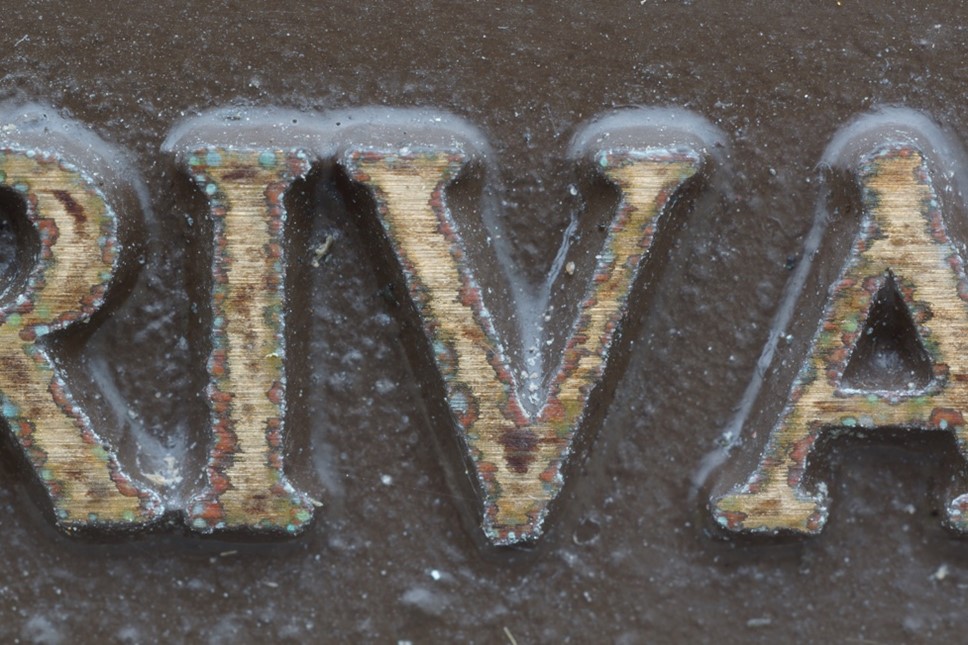 Figure 1: Bronze corrosion initiated underneath the clear topcoat of the lettering of a commemorative plaque.
Figure 1: Bronze corrosion initiated underneath the clear topcoat of the lettering of a commemorative plaque.
Catalan Institute of Nanoscience & Nanotechnology (ICN2)
Personnel
- Dr. Pablo Ordejón (research group leader – Theory & Simulation, Director of ICN2)
- Dr. Ernane de Freitas Martins (postdoc)
- José María Castillo Robles (PhD candidate)
Postdoc project – ‘Multi-scale QM/MM + NEGF Formalism to Address Electrified Metal/Water/Corrosion Inhibitor Interfaces’ (Ernane)
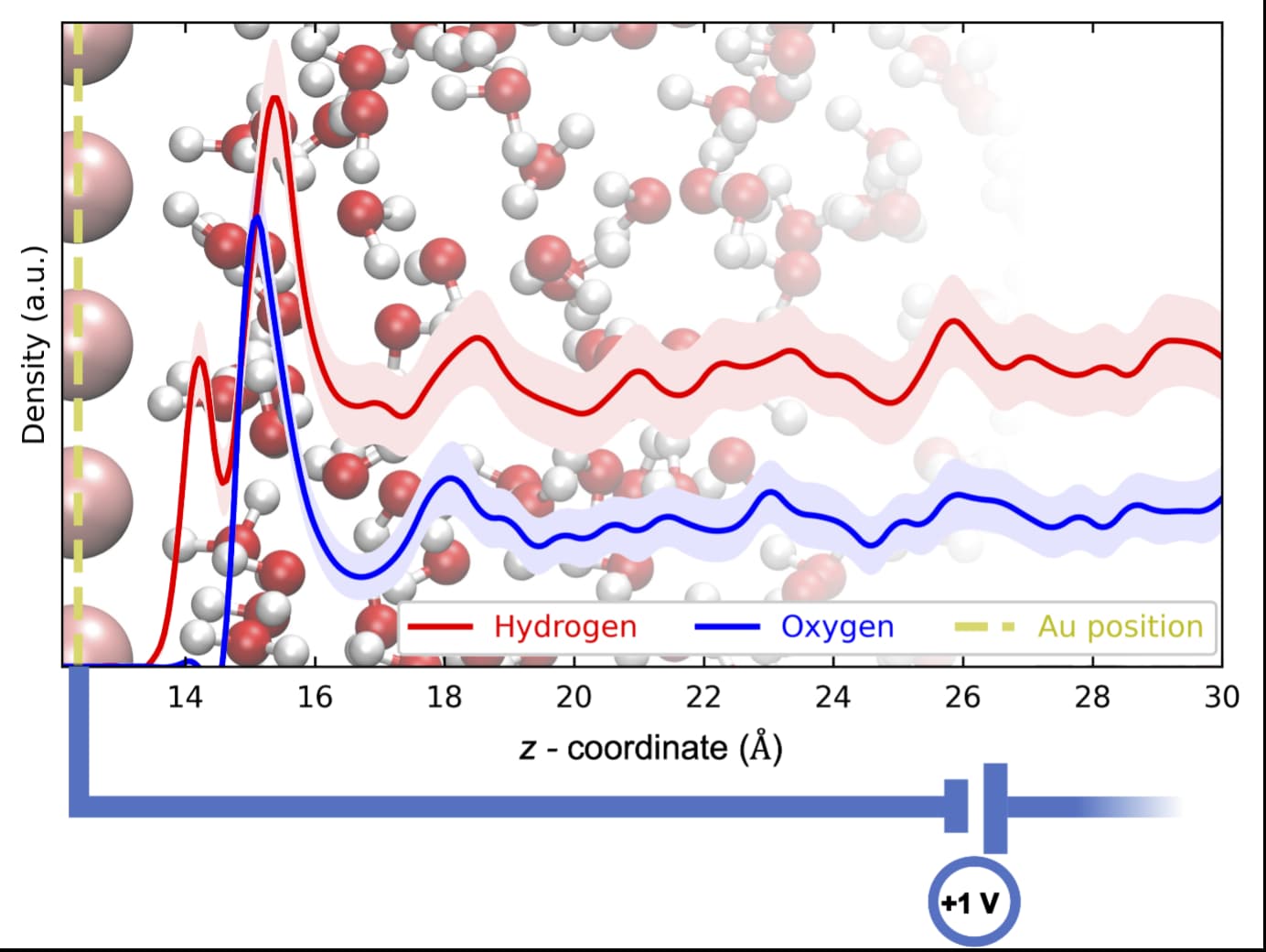 Figure 1: Quantum mechanics (QM)/molecular mechanics (MM) molecular dynamics simulation of the Au/H2O interface
Figure 1: Quantum mechanics (QM)/molecular mechanics (MM) molecular dynamics simulation of the Au/H2O interface
Electrified solid/liquid interfaces play a crucial role in many research fields related to electrochemistry, such as corrosion inhibition. However, including the electrode potential’s effect within modeling approaches is challenging. Also, the typical sizes of the systems needed to address realistic electrolytes are often prohibitive in terms of computational cost. Current literature usually neglects the effects of this voltage, which oftentimes neglects its important effects. Here, we propose tackling this problem using a multiscale approach by combining the non-equilibrium Green’s functions (NEGF) formalism with the quantum mechanics/molecular mechanics (QM/MM) method to balance the competing demands of accuracy & computational cost. Specifically, a fully quantum mechanical description of the metallic electrodes (under a voltage) is achieved via the NEGF, while the reduced cost of QM/MM simulations allows us to address realistic electrolytes.
PhD Project: ‘A Multiscale Approach to Bias-Dependent Electrochemical Processes at Metallic-Aqueous Interfaces: Corrosion Inhibitors’ (José)
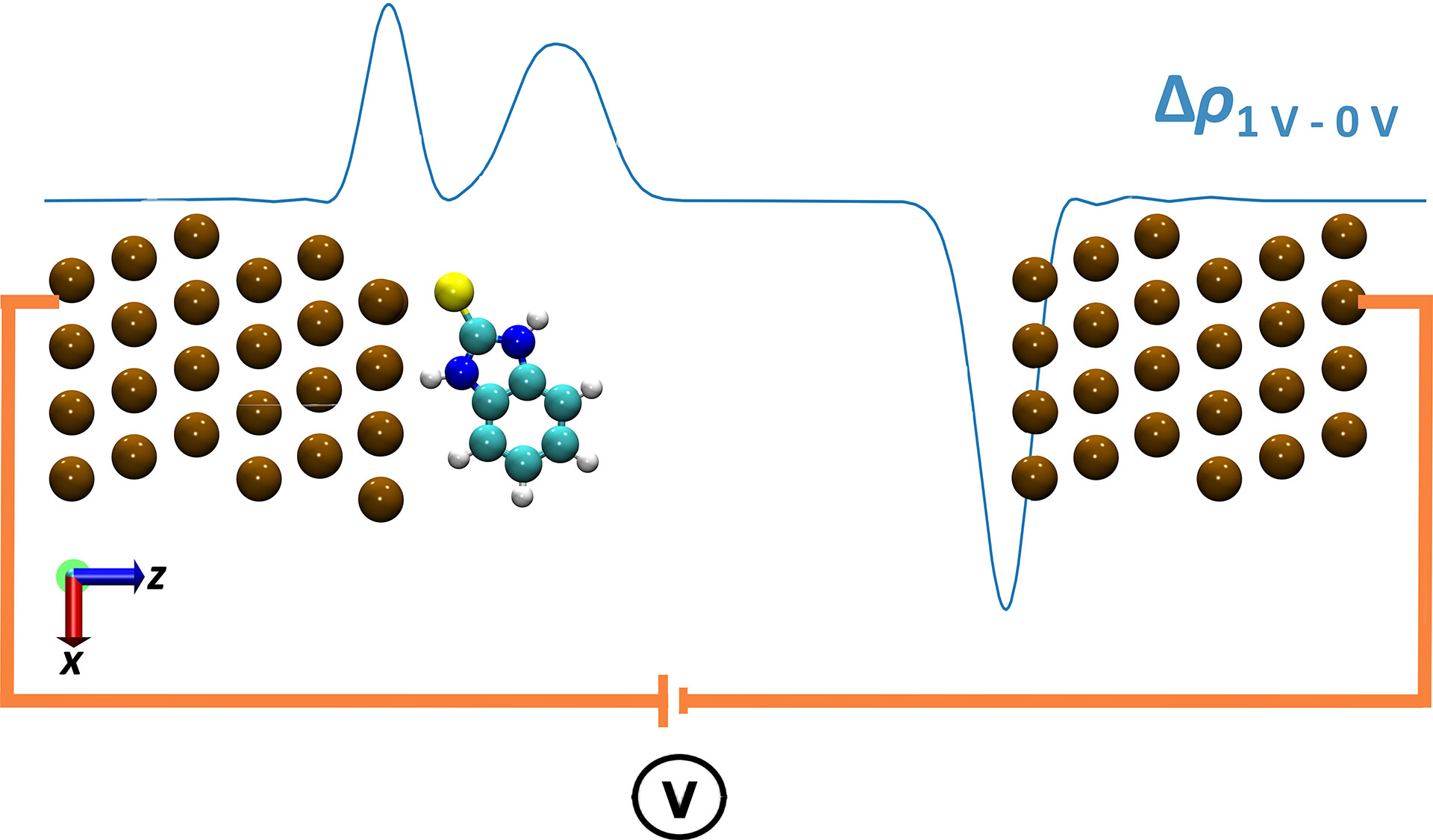 Figure 1: Electronic density difference (Δρ) between 1 V & 0 V for the adsorption of 2-mercaptobenzimidazole on a Cu surface. Ochre, yellow, turquoise, blue, and white-coloured spheres represent Cu, S, C, N, and H atoms.
Figure 1: Electronic density difference (Δρ) between 1 V & 0 V for the adsorption of 2-mercaptobenzimidazole on a Cu surface. Ochre, yellow, turquoise, blue, and white-coloured spheres represent Cu, S, C, N, and H atoms.
Corrosion is a critical technological problem and preventative methods are a highly active research area. Among other ways of inhibiting corrosion, the use of small molecules adsorbed on the material’s surface is remarkable. Currently, toxic inorganic compounds are often used for this purpose, leading to highly negative environmental implications. An alternative is the use of organic molecules with the ability to transfer charge to the surface, preventing its degradation.
From a simulation point of view, it is challenging to account for all factors involved in the adsorption of molecules on metallic – and potentially electrified – surfaces. This project aims to improve simulation resolution when exploring potential small organic molecules to mitigate corrosion in commercial aluminum alloys. To do so, we will use non-equilibrium Green’s functions (NEGFs) to fully account for the electrode’s potential. Realistic electrolytes will be included using the quantum mechanics (QM)/molecular mechanics (MM) method, achieving a good balance between computational cost & accuracy.
Victorian State Government
A new research project sponsored by the Victorian State Government’s Higher Education State Investment Fund (VHESIF) has brought together seven industry partners (from large multinationals to SMEs) and five research teams from across RMIT’s schools & disciplines to quantify Victorian workers’ risk of infection from poor indoor air quality.
This ethically approved research involves placing Internet-of-Things (IoT) sensors around industry worksites to anonymously track people movement, the flow of air, and indoor air quality. These worksites are then recreated digitally to predict how a virtual worker infected with COVID might infect others. These simulations are then a virtual test bed to determine the most cost-effective way to reduce infection risk, e.g. by altering HVAC settings, placing clear partitions, or placing air purifiers at strategic locations. The below images show the cumulative infection risk predicted within a scientific research laboratory by one worker infected with COVID-19.
Cumulative infection risk
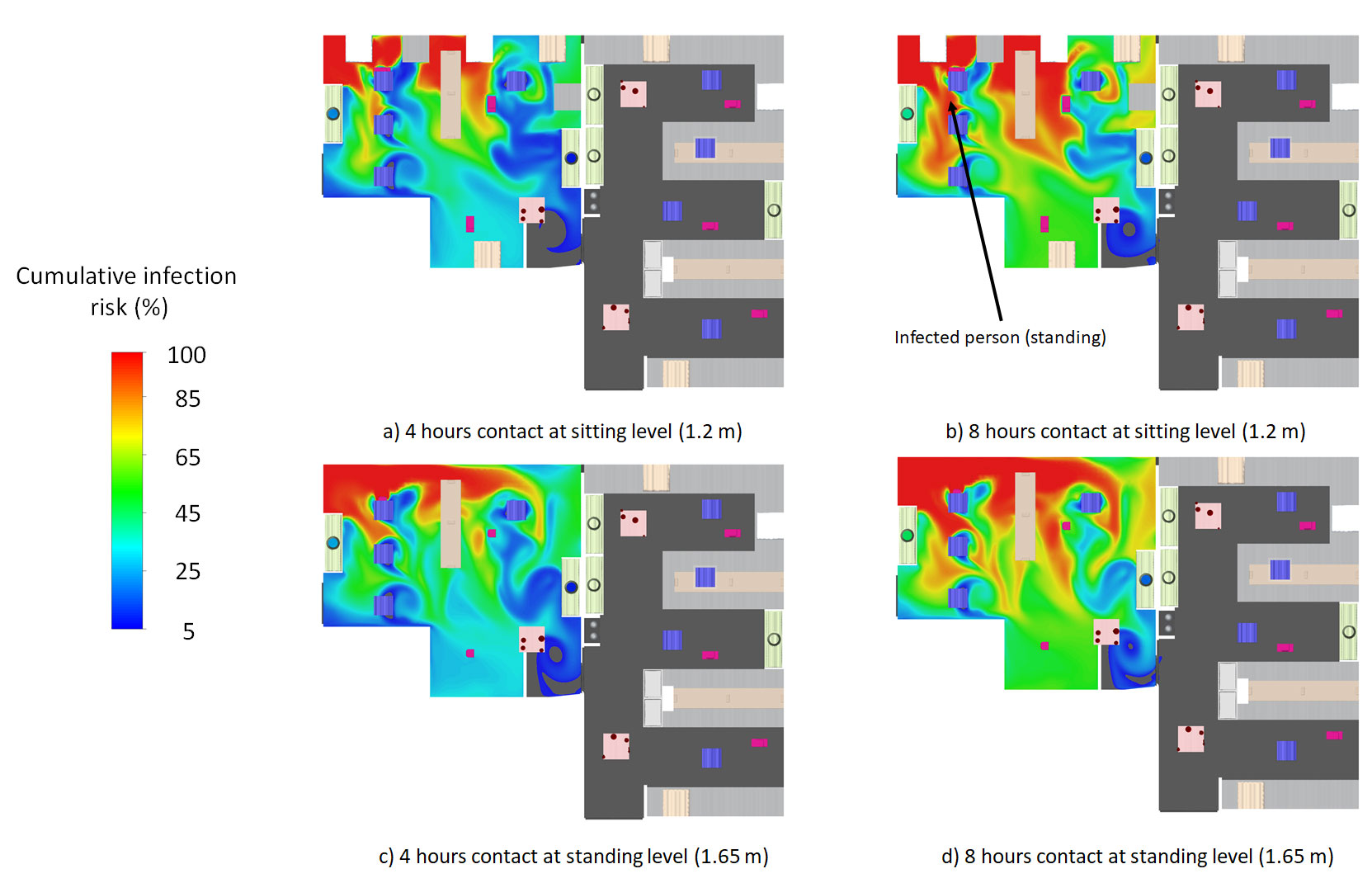 Figure 1: Two-dimensional cumulative probability of risk infection caused by an infected person working at a fixed location for 4 or 8 hours. It is assumed that the person is standing and spreading infectious aerosol particles from a 1.65 m height. The probability of infection is calculated considering the healthy person either sitting (1.2 m) or standing (1.65 m). Risk is calculated based on the assumption than neither the infected nor healthy person are wearing a mask or any other risk mitigation measurement. a) Accumulated risk at a height of 1.2 m after 4 hours of exposure. b) Accumulated risk at a height of 1.2 m after 8 hours of exposure. c) Accumulated risk at a height of 1.65 m after 4 hours of exposure. d) Accumulated risk at a height of 1.65 m after 8 hours of exposure
Figure 1: Two-dimensional cumulative probability of risk infection caused by an infected person working at a fixed location for 4 or 8 hours. It is assumed that the person is standing and spreading infectious aerosol particles from a 1.65 m height. The probability of infection is calculated considering the healthy person either sitting (1.2 m) or standing (1.65 m). Risk is calculated based on the assumption than neither the infected nor healthy person are wearing a mask or any other risk mitigation measurement. a) Accumulated risk at a height of 1.2 m after 4 hours of exposure. b) Accumulated risk at a height of 1.2 m after 8 hours of exposure. c) Accumulated risk at a height of 1.65 m after 4 hours of exposure. d) Accumulated risk at a height of 1.65 m after 8 hours of exposure
Cumulative infection risk
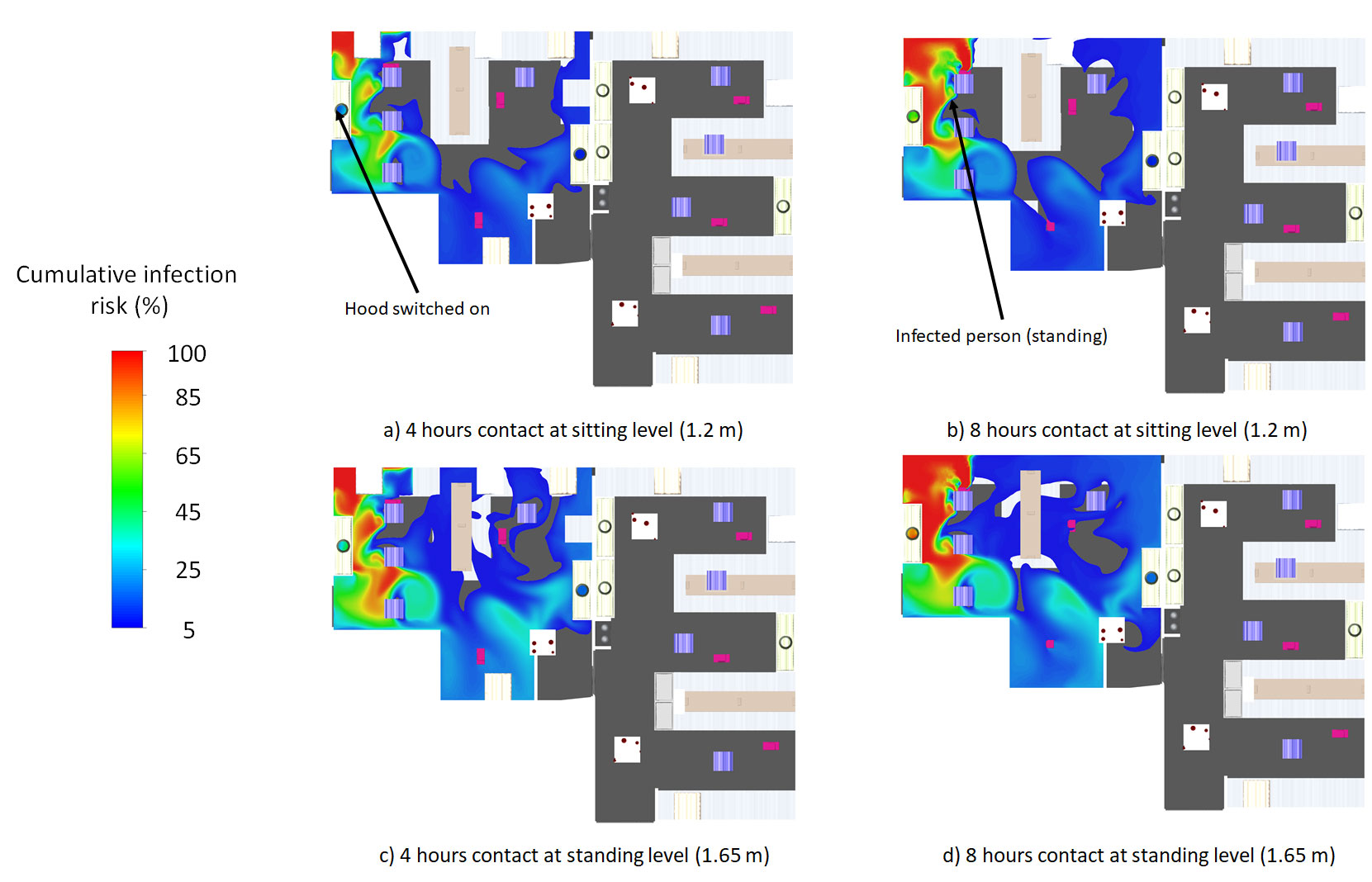 Figure 2: Two-dimensional cumulative probability of risk infection caused by an infected person working at a fixed location for 4 or 8 hours. It is assumed that the person is standing and spreading infectious aerosol particles from a 1.65 m height. The probability of infection is calculated considering the healthy person either sitting (1.2 m) or standing (1.65 m). Risk is calculated based on the assumption than neither the infected nor healthy person are wearing a mask and that the fume hood cabinet is switched on with its door open. a) Accumulated risk at a height of 1.2 m after 4 hours of exposure. b) Accumulated risk at a height of 1.2 m after 8 hours of exposure. c) Accumulated risk at a height of 1.65 m after 4 hours of exposure. d) Accumulated risk at a height of 1.65 m after 8 hours of exposure.
Figure 2: Two-dimensional cumulative probability of risk infection caused by an infected person working at a fixed location for 4 or 8 hours. It is assumed that the person is standing and spreading infectious aerosol particles from a 1.65 m height. The probability of infection is calculated considering the healthy person either sitting (1.2 m) or standing (1.65 m). Risk is calculated based on the assumption than neither the infected nor healthy person are wearing a mask and that the fume hood cabinet is switched on with its door open. a) Accumulated risk at a height of 1.2 m after 4 hours of exposure. b) Accumulated risk at a height of 1.2 m after 8 hours of exposure. c) Accumulated risk at a height of 1.65 m after 4 hours of exposure. d) Accumulated risk at a height of 1.65 m after 8 hours of exposure.
Cumulative infection risk
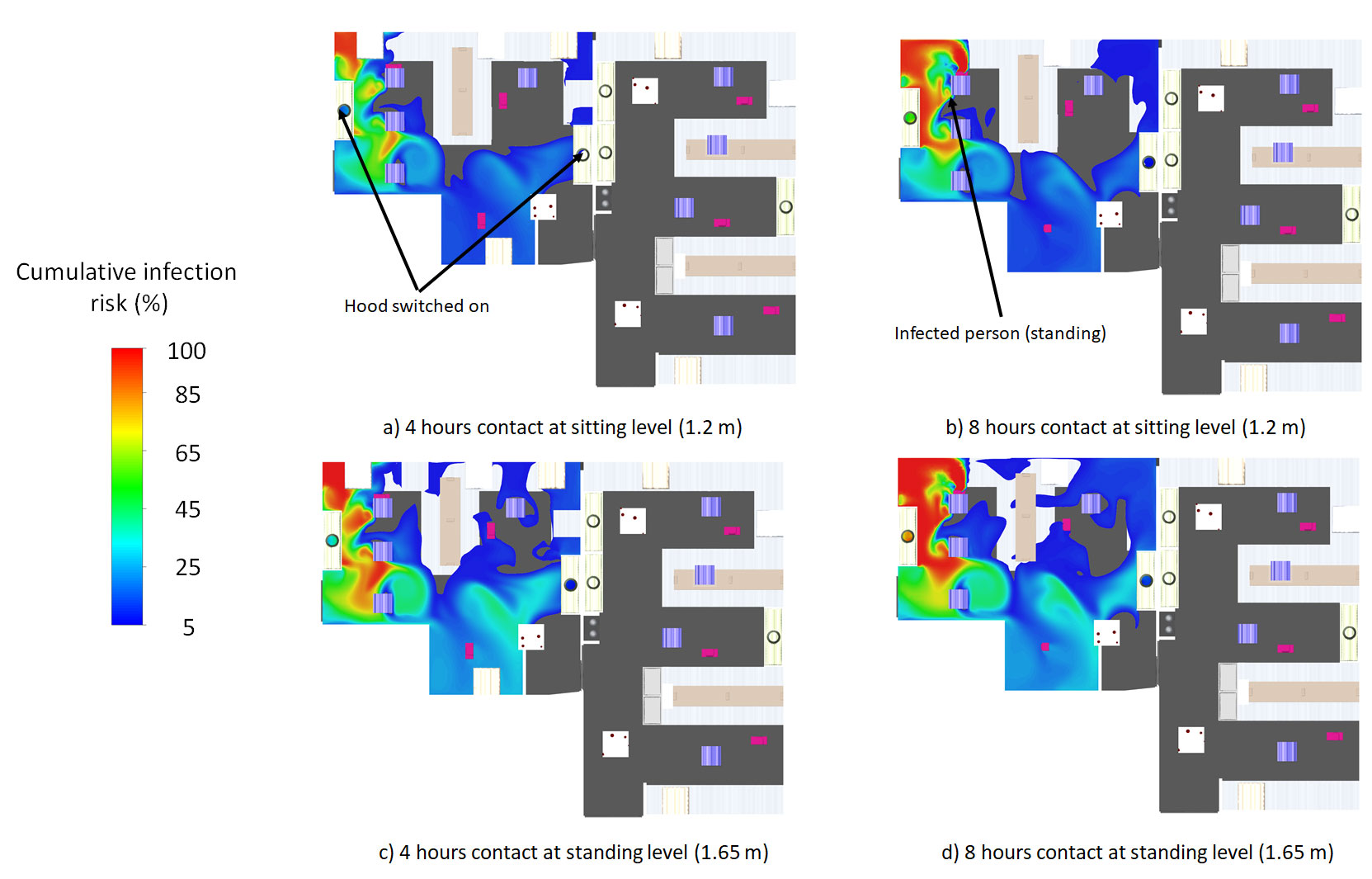 Figure 3: Two-dimensional cumulative probability of risk infection caused by an infected person working at a fixed location for 4 or 8 hours. It is assumed that the person is standing and spreading infectious aerosol particles from a 1.65 m height. The probability of infection is calculated considering the healthy person either sitting (1.2 m) or standing (1.65 m). Risk is calculated based on the assumption than neither the infected nor healthy person are wearing a mask and that the two fume hood cabinets at the room are switched on with their doors open. a) Accumulated risk at a height of 1.2 m after 4 hours of exposure. b) Accumulated risk at a height of 1.2 m after 8 hours of exposure. c) Accumulated risk at a height of 1.65 m after 4 hours of exposure. d) Accumulated risk at a height of 1.65 m after 8 hours of exposure.
Figure 3: Two-dimensional cumulative probability of risk infection caused by an infected person working at a fixed location for 4 or 8 hours. It is assumed that the person is standing and spreading infectious aerosol particles from a 1.65 m height. The probability of infection is calculated considering the healthy person either sitting (1.2 m) or standing (1.65 m). Risk is calculated based on the assumption than neither the infected nor healthy person are wearing a mask and that the two fume hood cabinets at the room are switched on with their doors open. a) Accumulated risk at a height of 1.2 m after 4 hours of exposure. b) Accumulated risk at a height of 1.2 m after 8 hours of exposure. c) Accumulated risk at a height of 1.65 m after 4 hours of exposure. d) Accumulated risk at a height of 1.65 m after 8 hours of exposure.
Our industry partners are receiving detailed feedback on the air quality & infection risk in their workplaces and are engaging with RMIT on approached for risk minimisation. Future work will involve extracting generic guidance for any Victorian workplace to reduce its risk of spreading airborne pathogens.


